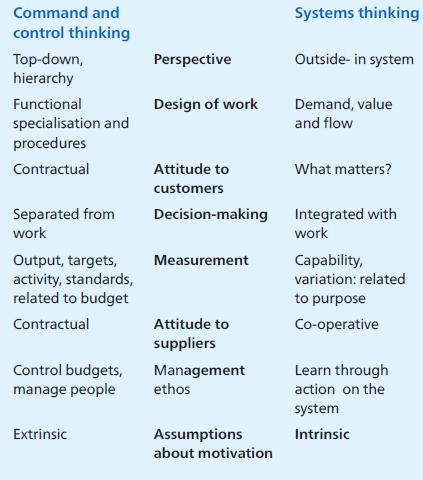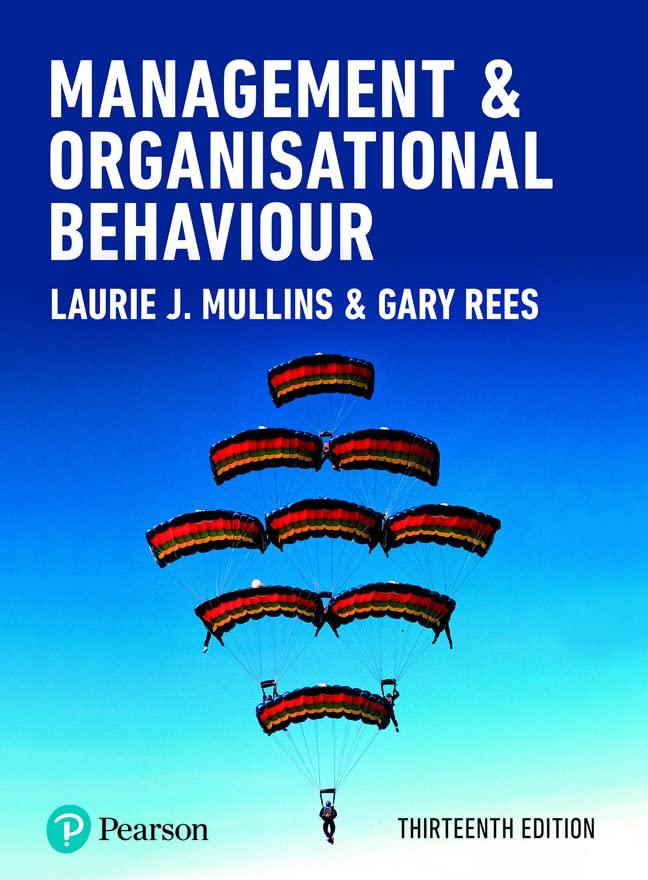A different, more recent approach to thinking about organisation and structure applied to the service industry is
Question:
A different, more recent approach to thinking about organisation and structure applied to the service industry is that of the ‘Vanguard Method’ which is based on the pioneering work of among others, W.
Edwards Deming, Chris Argyris and Taiichi Ohno. Ohno, the father of Toyota Production System, drew attention to managers’ lack of control on the shop floor and to the importance of continuous revisions, and his ideas gave rise to concepts such as Total Quality Management and Just In Time. Ohno viewed the work organisation as an integrated system with the focus on flow throughout the system rather than on individual functions. As Seddon notes: ‘In Ohno’s philosophy each person’s work is connected to the needs of customers, as opposed to arbitrary and counterproductive measures of activity’.60 Vanguard helps organisations change from command and control thinking to a systems thinking on the structure and design of work.
Emphasis is placed on the customer and measurement of success as opposed to targets of expected performance. The consequences are improved service to customers, at lower costs and improved morale. Service is different to manufacturing. In simple terms there is inherently greater variety in customer demand, hence the need to design to absorb that variety. We recommend that service organisations avoid the ‘tools’ developed for ‘lean manufacturing’ as they don’t apply well in service organisations.
Intrinsic to the Vanguard Method is the transfer of expertise to people (managers and staff) in the organisation.
Vanguard uses ‘sensei’, people who are experts in both intervention theory (how you make a change)
and systems theory (how to analyse and design work).
Vanguard senseis are experts in the ‘what’: how a systems design improves performance and the 'how': how to make this change. Steps in the Vanguard methods Understanding the distinctions – Top management must understand what it means to change from command and control to systems thinking.
Scoping – Assessing the scope for improvement; knowledge about customer demand, revenue and service flows, waste and the causes of waste; the potential scope and value of making this change in practical terms.
Check – People who do the work given technical support and check their understanding of the what and why of performance as a system.
Measures and method – In parallel with 'check', managers work on the relationship between measures and method, understanding the need to change and use of measures for managing and improving performance.
Prototyping – The 'check' team and managers work on measures and establish a prototype of the redesign.
The purpose is to develop the re-design and determine anticipated economies.
Leader’s review – In order to make informed choices about benefits from adopting the new systems design and authorises preparation for implementation.
Proof of concept – Prototype is extended and developed to handle all customer demands; the consequential improvements are tracked with new (system) measures while management develop a new budgeting and management information system.
Constancy of purpose – Leadership of the change with the top management team including in particularly roles and measures. Clarity about future state and means of implementation.
Implementation – Here a choice can be made:
establishing a working pilot (a complete re-design but limited in volume or scope); or making a complete change to the organisation.
Changes to policy and practice – Review matters of policy and practice. Typically they will include budgeting, HR policy and practice, interpretation of regulations and IT.
Finding out what matters to your customers – Having re-designed and improved your service, it is a natural extension to step over the boundary and learn about what matters to your customers. The work leads to new services, designed with customers.
Questions
1. What is your view of systems thinking as a further approach to organisation theory and structure?
2. To what extent do you agree with emphasis on the customer and measurement of success as opposed to targets of expected performance?
3. How far do you believe the idea of systems thinking could apply to both service and manufacturing organisations?
Step by Step Answer:

Management And Organisational Behaviour
ISBN: 9781292422381
13th Edition
Authors: Laurie Mullins, Gary Rees





